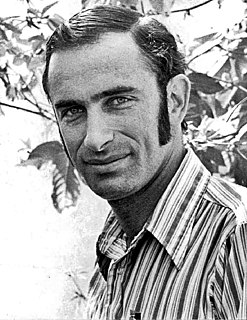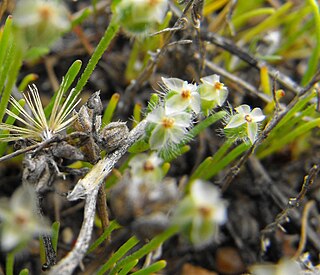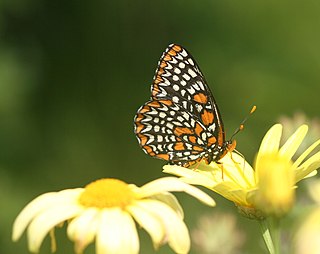
Paul Ralph Ehrlich is an American biologist, best known for his warnings about the consequences of population growth and limited resources. He is the Bing Professor Emeritus of Population Studies of the Department of Biology of Stanford University and President of Stanford's Center for Conservation Biology.
Local extinction, also known as extirpation, is the condition of a species that ceases to exist in a chosen geographic area of study, though it still exists elsewhere. Local extinctions are contrasted with global extinctions.
LuEsther Turner Mertz was a businesswoman and philanthropist. She was the youngest child of a Methodist minister and his wife and trained as a librarian at Syracuse University.

Eriodictyon californicum is a species of plant within the family Boraginaceae. It is also known as yerba santa, mountain balm, bear's weed, gum bush, gum plant, and consumptive weed. Less common names include Herbe des Montagnes, Herbe à Ourse, Herbe Sacrée, Herbe Sainte, Hierba Santa, Holy Herb, and Tarweed.

The Uncompahgre fritillarybutterfly is a species of butterfly in the Order Lepidoptera: Family Nymphalidae that is endemic to Colorado, USA.

Scrophularia californica is a flowering plant in the figwort family which is known by the common names California figwort and California bee plant.

Orthocarpus, or owl's-clover, is a genus of flowering plants in the family Orobanchaceae. They are native to North America. A number of species formerly included in Orthocarpus have been transferred to the genus Castilleja, which includes the plants commonly known as Indian paintbrush.

The variable checkerspot or Chalcedon checkerspot is a butterfly in the family Nymphalidae. It is found in western North America, where its range stretches from Alaska in the north to Baja California in the south and extends east through the Rocky Mountains into Colorado, Montana, New Mexico and Wyoming. The butterfly is usually brown or black with extensive white and yellow checkering and some red coloration on the dorsal wing. Adult wingspan is 3.2–5.7 cm (1.3–2.2 in). Adult butterflies feed on nectar from flowers while larvae feed on a variety of plants including snowberry (Symphoricarpos), paintbrush (Castilleja), Buddleja, Diplacus aurantiacus and Scrophularia californica.

Plantago erecta, in the plantain family, is known variously as California plantain, foothill plantain, dot-seed plantain, English plantain, and dwarf plantain.

The Baltimore checkerspot is a North American butterfly of the family Nymphalidae. It has been the official state insect of the U.S. State of Maryland since 1973. The Baltimore checkerspot was named for the first Lord Baltimore due to its similarity of colors in the family crest. Despite the species status as Maryland state insect, the population in Maryland has faced significant decline and is currently listed by the Maryland Department of Natural Resources as "rare, threatened, and endangered" animal list.

The Quino checkerspot is a butterfly native to southern California and northwestern Baja California. It is a subspecies of the common Edith's checkerspot and the second such subspecies to be listed under the federal Endangered Species Act.

Edith's checkerspot is a species of butterfly in the family Nymphalidae. It is a resident species of western North America and among the subspecies, entomologists have long been intrigued by their many phenotypic variations in coloration, wing length, and overall body size. Most populations are monophagous and rely on plants including Plantago erecta and Orthocarpus densiflorus as its host species in developing from eggs through to larvae, pupae, and mature butterflies. Males exhibit polygyny whereas females rarely mate more than once. Males devote most of their attention to mate acquisition, and such mate locating strategies such as hilltopping behavior has developed. Climate change and habitat destruction has impacted certain subspecies. Two subspecies in particular, Euphydryas editha quino and Euphydryas editha bayensis, are currently under protection via the Endangered Species Act.

Euphydryas editha taylori, the Whulge checkerspot or Taylor's checkerspot, is a butterfly native to an area of the northwestern United States and Vancouver Island.

The Bay checkerspot is a butterfly endemic to the San Francisco Bay region of the U.S. state of California. It is a federally threatened species, as a subspecies of Euphydryas editha.

Euphydryas anicia, the anicia checkerspot, is a species in the family of butterflies known as Nymphalidae. It was first described by Edward Doubleday in 1847 and it is found in North America.
Robert F. Sternitzky was a United States lepidopterist and illustrator. Butterfly and moth specimens he collected are in a number of collections, including those of the Harvard Museum of Natural History, the Essig Museum of Entomology, Manitoba Museum, and the Smithsonian National Museum of Natural History. He collected primarily in California and Arizona.
Susan Patricia Harrison is a professor of ecology at the University of California, Davis who works on the dynamics of natural populations and ecological diversity. She is a fellow of the Ecological Society of America and the California Academy of Sciences. She has previously served as vice president of the American Society of Naturalists. She was elected to the National Academy of Sciences in 2018.

Carol Linda Boggs is an American biologist specializing in the reproductive biology, population biology, ecology, and evolution of butterflies. Boggs completed her BA in 1973 and her PhD in 1979 in zoology at the University of Texas at Austin. Since 2013, she has been a professor in the School of the Earth, Ocean and Environment and the Department of Biological Sciences at the University of South Carolina. Boggs is the author of more than 120 peer-reviewed articles and has served on editorial boards for several journals. She has been a fellow of the American Association for the Advancement of Science since 2001.













